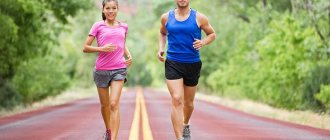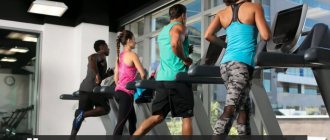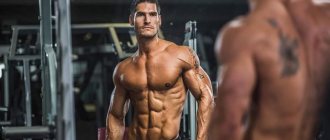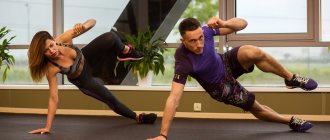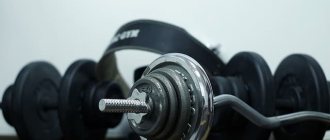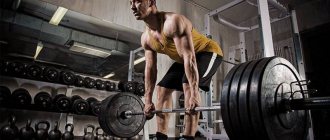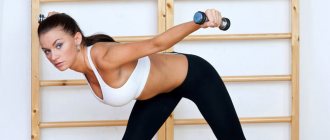Running and strength training[edit | edit code]
The running disciplines in athletics cover all types of running over distances of 800 m. The Olympic sport with the longest distance (42.195 km) is called the marathon. In addition, there are other official running competitions with significantly longer distances. For a long time, the ability to achieve high achievements in running was explained exclusively by the physiological characteristics of metabolism, which prevent muscle contractions under the influence of increasing load. Previously, it was assumed that runners' performance was determined by the function of the cardiovascular system and the ability to consume the maximum amount of oxygen. Recently, there has been a growing consensus that in running disciplines, stimuli acting on skeletal muscles play a particularly important role.
Running while gaining muscle mass
Find out if running is good for gaining muscle mass.
Today, the topic of combining running and strength training during the period of weight gain is being discussed very vigorously. We can say that bodybuilders are divided into two groups on this issue. Some of them are sure that running can harm the process of gaining weight, while others adhere to the exact opposite point of view.
Supporters of jogging claim that if a running training program for gaining muscle mass is designed correctly, then aerobic exercise will be very useful. We believe that running is effective only during drying, and when gaining weight, aerobic exercise should be excluded from the training. Let's start with a couple of myths associated with running.
Myths about running
Running improves heart performance
Almost every running fan, when talking about the benefits of running, will immediately declare an improvement in the performance of the heart muscle.
With the fact that during running the heart is forced to contract more often, it is useless to drink, since this is a fair statement. But strength training also helps to increase heart rate, and, therefore, can improve the functioning of the heart muscle.
Important!
This is especially noticeable when performing basic movements, when a large number of muscles are involved in the work.
It should also be noted that strength training provides interval stress on the heart muscle, which is much more beneficial in comparison with a constant powerful load. However, this can also be achieved when running, using interval runs.
Running is very effective for reducing fat tissue
It is generally accepted that running can help you quickly lose weight. However, this is not entirely true, because today it has been proven that aerobic exercise can burn not as many calories as was previously thought.
If you weigh 80 kilos, you can burn about 400 calories in 30 minutes of jogging. This is not as outstanding a figure as it might seem. Just look at the calorie content of food and see for yourself.
A much more important effect of any aerobic exercise is that the body continues to expend energy after the exercise is completed. However, strength training has its advantages in this matter.
Scientists have proven that muscles, even at rest, require a lot of energy. To put it simply, even sitting on the couch, a bodybuilder continues to lose calories, since muscles need them.
The more muscle mass you have, the higher your metabolism, and therefore your energy expenditure.
Is running necessary when gaining weight?
Sometimes you can come across the opinion that by running you can increase muscle mass. The reasons for such a statement are completely unclear.
Today we can say for sure that for muscle growth you need proper nutrition when gaining muscle mass, as well as strength training. Through nutrition, we provide the body with the nutrients necessary for muscle growth.
Strength training, in turn, accelerates the production of anabolic hormones that activate muscle fiber growth processes.
Advice!
Running, like any aerobic exercise, causes the opposite reaction of the hormonal system, and the body begins to actively produce catabolic hormones.
In this light, talking about muscle growth after running is completely inappropriate. Sometimes bodybuilders use jogging during breaks between strength training sessions in the hope of accelerating mass gain.
But this only slows down the recovery of the body.
As you should know, muscle growth is only possible after the body has recovered. Otherwise, you may find yourself in a state of overtraining.
Thus, if you want to increase muscle size, then you need to give up aerobic exercise.
But sports nutrition for gaining muscle mass will be very appropriate, since with the help of ordinary products over time it will be extremely difficult to provide the body with all the necessary substances.
The importance of training muscle strength in running disciplines[edit | edit code]
For a long time, high performance in running was considered solely from a physiological point of view. The main factors of sports performance were considered to be the functions of the cardiovascular and respiratory systems, as well as the concentration of lactates and other metabolic products. Especially in mass sports, strength is not connected in any way with running results. This may be because strength training is usually associated with bodybuilding and strength training for running is generally under-emphasized and sometimes even neglected.
However, regular strength training is essential for running athletes because it helps build a stable muscular corset in the torso and protect the joints of the lower extremities through the development of the corresponding muscles. In addition, also in running, sufficient speed is only possible with a certain level of strength.
The most important criterion for a runner is maintaining proper technique. At the same time, an athlete’s result can be high only with a certain development of the trunk muscles, which is a key factor in performance in other sports. Correct posture is a fundamental element of movement. In order to maintain it, strength training of the back and abdominal muscles is necessary.
In addition, the correct position of the pelvis plays an important role in running; the hip joints must be actively positioned in such a way as to prevent the so-called sitting running. This requires targeted strength training of the relevant muscles - especially all the gluteal, adductor and abductor muscles, which also stabilize the position of the pelvis.
The leg muscles are important for active movement and stability, and also protect the joints (knees and ankles), which bear the bulk of the load.
For runners, the goal of strength training is not to increase muscle mass, but to increase the strength of existing (usually bulky) muscles. Typically, such training also includes an endurance training component and is carried out in the form of strength endurance training.
What muscles work when jogging, climbing stairs and with dumbbells?
Beginners asking questions about what muscles work when running pretty much confuses any fitness trainer. The problem with this type of activity is that the muscles in your legs, core, arms, and abdomen can contract. But “pumping up” or “lifting” may not happen to them.
The thing is that “slow” muscle fibers work predominantly, which are not able to achieve significant hypertrophy. This means that we will not get the “athlete’s body” visual effect from this.
Speaking of which, runners don't look like motivating fitness models. The typical track and field athlete has a lack or normal amount of muscle mass, a healthy percentage of body fat, and a fairly smooth body contour. Dried abs, hypertrophied hips and buttocks and prominent shoulders - this is about professional sports. But running can still be useful if you do it right.
Is it worth running at all?
We honor modern fitness training gurus. Katya Usmanova writes on her blog that she has given up running and advocates non-impact cardio on a stepper and walking uphill on a track. She claims that the fitness specialist is more likely to injure the joints and overload the nervous system, but will not get from running what all women want - a beautiful figure, round buttocks, slender legs and good posture.
Radical coach Anas Nuriev generally despises running. He believes there are more humane ways to increase physical activity, such as simple walks, shopping or being active with children.
Running, according to this trainer, is a manifestation of an irrational approach to fitness. What should be done? Classic and front squats, deadlifts, presses, pull-ups and other strength exercises.
At the same time, there are many running schools that are ready to make you run a half marathon, help you improve your technique and time, and claim that there is no physical activity better than running.
Strength training for running[edit | edit code]
In all types of running, as a fundamental condition for training, in addition to the constant development of general endurance, it is necessary to improve strength indicators throughout the entire training year. The most important condition for strength training for runners is a stable muscular corset of the torso and pelvis (supporting muscles), as well as good development of the main muscle groups. These muscles need to be constantly developed and trained.
Due to the specific requirements in all types of running, the main importance is given to the development of strength endurance, but in parallel, fast strength should also be purposefully improved, especially when running over shorter distances (medium distance), where a relatively high running speed is required.
But, since training to improve results and achieve higher sportsmanship is based on the indicator of maximum strength, its targeted development is an obligatory element of the training process. During the year, strength training is concentrated on the preparatory stages - general and special. At this time, strength training is carried out 2 times a week. At the stage of achieving the highest sports mastery, strength training is necessary once a week. This is especially important during a long competitive season. The optimal effectiveness of strength training can be achieved if you devote 45-60 minutes to it during a training session.
At the stage of general developmental training, in addition to developing the strength of the muscles of the trunk and pelvis, there is a targeted improvement of the complex strength indicators of the arms and legs in the process of strength endurance training. The forms of strength endurance training are circuit training and block training. Individual blocks include various exercises for all muscles of the trunk and pelvis, all muscle groups that play a particularly important role in running (gluteal muscles, thigh muscles, lower legs and feet), as well as muscles of the upper limb and shoulder girdle.
The degree of load and its intensity determine the sequence of exercises, the number of blocks (10-15), the duration of exercises and intervals (for example, 15/30.30/30.45/30 sit. days), as well as the number of approaches and pauses between them.
At the stage of special training, in addition to further development of strength endurance, fast strength of the muscles of the buttocks, legs and feet directly involved in running, as well as other involved muscle groups (arms/shoulders), is trained.
The forms of training used correspond at certain stages to the structure of movements during competitions, differing from them, however, in the dependence of strength on time. In this case, all types of flexion-extension exercises are used - with and without weights, training on apparatus, jumping, including jumping over obstacles (bench, box, barriers), jumping on stairs, running with hops and running with jumps.
The next stage of training is running-specific strength training, which uses intense running variations (tempo running and speed training), as well as hill running and running with a traction device.
In table The forms and means of training used at individual stages of the training year are given.
Table. Review of the main forms and means of strength training in running
| General developmental strength training (strength endurance) | Specific strength training (strength endurance, fast strength, maximal strength if necessary) | Strength training taking into account the specifics of running (fast strength, strength endurance) |
| "Track and Field Turns" | Exercises on simulators to straighten the legs at the knees, buttocks and feet | Tempo run |
| Circuit and block training for the entire muscular system | Strengthening the hip and calf flexor muscles (ischiocrural muscles) | Running uphill |
| Strength exercises for the torso and pelvis | Strengthening the foot extensors | Running with a traction device |
| Exercises to improve foot stability | *Squats * Lifting the barbell with a jerk *Strengthening hands *Small jumps *Jumping, including over obstacles, jumping and running on stairs *Running with hops, running with jumps | Sprinting |
How to run to gain mass in bodybuilding bodybuilding
There are undoubtedly benefits of running in bodybuilding. Many athletes use running to gain mass (muscle mass). Fact - bodybuilders run to gain mass! However, most bodybuilding trainers at gyms will directly tell you to forget about running while lifting weights.
But why? The fact is that they are well aware of the benefits of running for the muscle building process, but tell a beginner to run and pump. And what the latter will do. He will run around like crazy, thinking that this is how his muscles will grow.
He will spend all his strength and remaining resources in his body on running.
And there will be nothing left for muscle growth, because the body first of all tries to restore energy resources, and only then (provided that some resources are left) begins to build muscle mass.
No one will explain to you how to run correctly. It’s easier to say don’t run than to spend a lot of time explaining the diagrams.
But let's try to analyze the running process.
Advice!
So. Women often run, or think that women run. They go out to the stadium and do 5-10 laps in an easy jog. This takes them 10-15 minutes. No more. Well, depending on what kind of circles.
Meanwhile, the benefits of running, both as a workout for the heart, leg muscles and burning excess fat, only begin to appear after 20 minutes of moderate intensity running, not fast, but not at a relaxed pace (as some put it).
That is, 20 minutes of running puts almost no strain on your body. The conclusion from here is that you need to run for at least 30 minutes at a time.
But if we are engaged in bodybuilding, then how to run then.
Let's take the most common training program scheme, but it is far from the most effective and correct in terms of weight gain. For example, we swing Monday-Wednesday-Friday. Three times a week.
Running is an aerobic exercise, an endurance exercise.
So, it would be ideal to run on days when there are no workouts: Tuesday, Thursday and Saturday. Sunday is a day off.
But how to run?
You need to run for 30 minutes. The pace is moderate. You can’t suck all the juices out of your body by running. But running and not breaking a sweat is a waste of time. You should start the “race” at a slow pace, gradually accelerating. You need to accelerate very slowly, over 10-15 minutes. Faster and faster.
You need to give your breathing time to adapt to the accelerating pace of running. If you start to accelerate quickly, the oxygen reserves in your body will quickly run out, and the new one will not have time to arrive due to the lungs not being ready and the lack of time to saturate (fill) the blood with oxygen. Oxygen starvation of the muscles will occur.
Attention!
These are muscle spasms, a sharp desire to stop, greedy swallowing of air through the mouth.
During this period, your body sucks out from the muscles everything that may be useful there. This is of no use to us.
On the contrary, by giving 10-15 minutes to increase the running speed to almost maximum, we will have time to prepare the lungs for intense work. Let's warm up the muscles and pump up the heart. The heart is the same muscle and it cannot be given the maximum load right away - warm-up sets are necessary.
We start slowly and gradually increase the speed. But without effort. Everything should be within the limits of your strength and endurance. I always speed up unconsciously. As my lungs get used to it and my muscles warm up, my legs gradually begin to work faster on their own, but I just can’t keep them up. I don’t command them, they run as they please.
And in this way we avoid oxygen starvation and preserve muscles. And the last 15 minutes we run quite quickly. But again, if after 10 minutes you are already pretty tired, then don’t break your ass, start slowing down your running pace. After a week, you will still get into the rhythm and will be able to run very fast for 15 minutes without any problems.
And the last 5 minutes you need to slow down. Before switching to fast walking, slow walking and a full stop at the end of the path near the entrance of your house.
And they ran, shook the body, launching recovery processes, and then got rid of toxins that had accumulated during the last workout, and sent oxygen through the muscles, and the heart was tightened, and the brain was enriched with oxygen (and this will allow the muscles to respond more clearly to commands from the center of the head), and we lost excess fat and worked up an appetite, and when we come home, we get calories from food and will additionally help our muscles in the process of gaining weight.
There are more than enough benefits from running for a bodybuilder. And there is no need to talk about harm at all. The main thing is not to push yourself and not to give 100% in running. You should only run for pleasure, but don’t skimp on it!
Example of strength training[edit | edit code]
Strength exercises for track and field athletes are no different from exercises for bodybuilders, weightlifters, and fitness groups. Particular attention is paid to the effects on the muscles of the legs, back, upper shoulder girdle, and abdomen.
To increase the cross-section (swing) of the muscle, it is necessary to do a small number of repetitions (up to 10) with a large weight (close to the maximum).
In this case, exercises are done to failure, that is, to the point where the action can no longer be physically performed. To strengthen the muscle and tone it, a large number of repetitions are performed with light weight.
Strength exercises are divided into exercises with your own weight and with weights (stones, barbells, weights). Such exercises (especially with weights) are carried out under the supervision of a trainer, since the slightest inaccuracies in posture or technique can lead to injuries.
The weight of the weight is selected depending on the weight, gender, age, and level of physical fitness of the runner.
It is not recommended for teenagers to use heavy weights, as bone growth is still ongoing, and lifting heavy weights can negatively affect their development. Women should also be careful about heavy weights: due to the heavy load on the pelvic area, problems with childbearing are possible.
All exercises with a barbell that are aimed at strengthening the muscles of the legs (squats, half-squats) and back (bends, jerks, pushes) are performed in a special belt that reliably fixes the lumbar spine and prevents the vertebrae from moving.
Bodyweight exercises[edit | edit code]
The exercises are designed to help strengthen muscles. One series should include 20-30 repetitions. Exercises 1-7 put a greater load on the muscles of the legs, 9 - on the arms and upper shoulder girdle, 8, 10-13 - on the abdominal muscles.
Exercise 1. Sharp squats.
Initial position
- standing on your toes, legs slightly apart. Place your arms straight above your head. Perform a squat, with your knees spread to the sides (Fig. 5.37). Returning to the starting position, sharply straighten your knees.
Exercise 2. Squats on toes.
Initial position
- standing on your toes, hands joined in a lock at the back of your head (Fig. 5.38, a). Perform a squat while remaining on your toes (Fig. 5.38, b). Do not spread your knees (directed forward). Returning to the starting position, try to straighten your legs sharply.
Exercise 3. Lunges.
Initial position
- standing, feet shoulder-width apart, hands connected above the head (Fig. 5.39, a). Take a sharp long step, transferring your weight to the bent leg (Fig. 5.39, b), then just as quickly return to the starting position. Perform the exercise alternating legs.
Exercise 4. Squats on one leg with support.
Initial position
- standing, body parallel to the floor, arms extended forward. Your partner supports you by your straightened leg (Fig. 5.40, a). Bend your supporting leg, leaving your arms straightened horizontally, then stand up sharply (Fig. 5.40, b).
Exercise 5. Squats on one leg
Initial position
- sitting on one leg with emphasis on the hand. The second leg is straight at the knee (Fig. 5.41). Stand up quickly. Return to the starting position.
Exercise 6. “Pistol”.
Initial position
- standing, feet shoulder-width apart. Stretch your arms forward and squat as low as possible on one leg (Fig. 5.42). Return to the starting position.
Exercise 7. Raising the torso.
Initial position
- kneeling (Fig. 5.43, a). Perform the exercise slowly and carefully. Tilt your pelvis back and stand up without the help of your hands or support (Fig. 5.43, b).
Exercise 8. “Corner” from a lying position.
Initial position
- lying down, arms extended (Fig. 5.44, a). Raise your straight legs so that they form a 90° angle with the surface (Fig. 5.44, b) and slowly lower them. You can complicate the task: after raising your legs, lower them to the left, lift them, lower them to the right, lift them, and only then lower them to the starting position.
Exercise 9. Push-ups.
Basic rules for push-ups: the torso should be extended in a straight line (do not lift your pelvis or bend, arms straight shoulder-width apart, legs together (Fig. 5.45, a). Perform push-ups until your chest touches the surface (Fig. 5.45, b). Watch your breathing: start the exercise - inhale, end the exercise - exhale.
Do not hold, speed up or slow your breathing.
Exercise 10. “Folding Knife”
From a supine position, arms extended (Fig. 5.46, a), at the same time raise your arms and legs so as to connect them approximately above the pelvis (Fig. 5.46, b).
Smoothly lower yourself to the starting position.
Exercise 11. Abdominal exercise.
From a hanging position on the gymnastic wall, raise your legs bent at the knees to chin level (Fig. 5.47).
Exercise 12. “Corner” in the hang.
On the gymnastic wall while hanging, raise your legs straight at the knees to a horizontal level (Fig. 5.48). There is a more difficult version of this exercise - while hanging on the bar, raise your legs straight at the knees until you touch the bar (fully folded).
Exercise 13. “Corner” on an inclined bench.
It is performed with clear fixation on an inclined bench. With your legs straight at the knees, raise your body to an angle of 90° (Fig. 5.49) or raise your torso to your legs, an angle of 90° (Fig. 5.50).
Weight-bearing exercises[edit | edit code]
Exercise 1. Swings with weights on the shins.
Perform swings to the sides, angle 45° (Fig. 5.51, a) or forward - backward, angle 90° (Fig. 5.51, b).
Exercise 2. Leg press on the “Leg Press” machine.
Perform from the starting position in which your legs rest with your full feet on the base, closed together. Extend from a position of fully bent legs (Fig. 5.52).
Exercise 3. Squats with dumbbells.
Perform a deep squat with dumbbells in your hands, place your heels on a stand 5-10 cm thick (Fig. 5.53).
Exercise 4. Half squats with a barbell.
Bend your legs to a horizontal level, pressing your heels to the ground (Fig. 5.54).
Exercise 5. Lunges with a barbell.
From a standing position, take long steps with a squat in the last phase. Perform by alternating legs (Fig. 5.55).
Exercise 6. Deep squats with a barbell.
Perform on a stand under your heels, squatting as deeply as possible (Fig. 5.56).
Exercise 7. Raising legs from a sitting position.
Sitting on a machine bench, slowly raise your legs, straightening them at the knee joint (Fig. 5.57).
Exercise 8. Raising legs from a lying position.
Bend your legs at the knee joints until the machine stops (Fig. 5.58).
